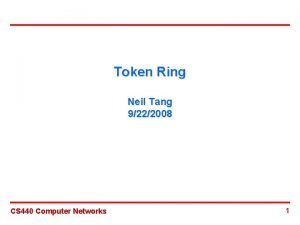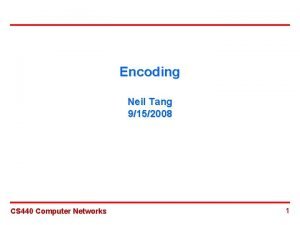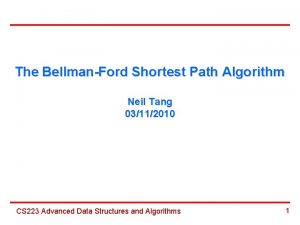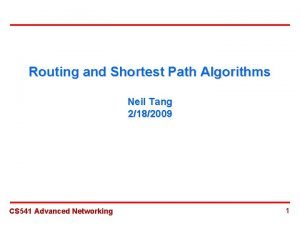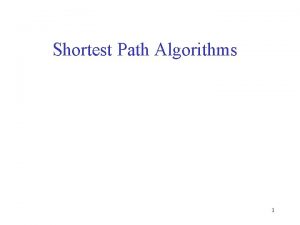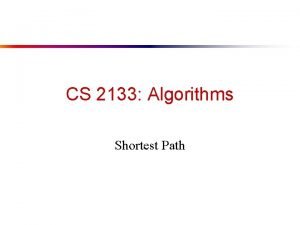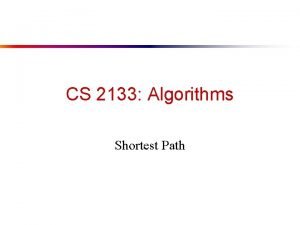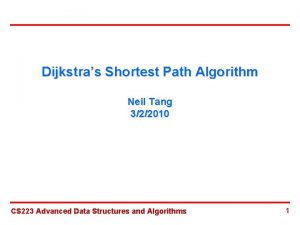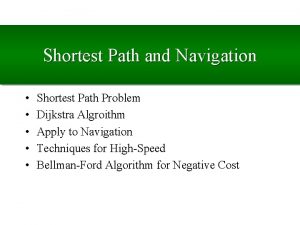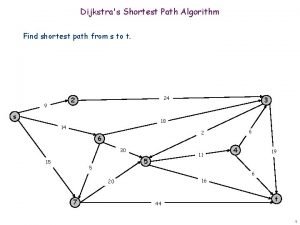Routing and Shortest Path Algorithms Neil Tang 2182009









- Slides: 9

Routing and Shortest Path Algorithms Neil Tang 2/18/2009 CS 541 Advanced Networking 1

Outline Ø Network Model Ø Link and Path Costs Ø Routing Problems Ø Dijkstra’s Shortest Path Algorithm Ø Constrained Shortest Path Algorithms CS 541 Advanced Networking 2

Network Model Ø A network is usually modeled as a graph such that the networking problems, such as routing and scheduling, can be transformed to the corresponding problems in a graph and solved by algorithms in graph theory. Ø A vertex in the graph represents a router. Ø In a wired network, there is an edge (A, B) between a pair of vertices A and B if there is a physical link in between. Ø Disk graph: In a wireless network, there is an edge (A, B) between a pair of vertices A and B if their Euclidean distance is no more than the transmission range of node A. CS 541 Advanced Networking 3

Link and Path Cost Ø There is usually one or multiple cost parameters associated with each link, which indicate its transmission cost, bandwidth, delay and so on. Ø Some of parameters are bottleneck parameters (e. g. bandwidth), i. e. , the cost of the path in terms of this parameter depends on the minimum link cost along the path. Ø Some of parameters are additive parameters (e. g. delay), i. e. , the cost of the path in terms of this parameter is equal to the summation of the costs of all links along the path. CS 541 Advanced Networking 4

Routing Problems Ø Basic routing problem: Given a source and a destination, the basic routing problem seeks a source-destination route such that it has the minimum cost among all possible source-destination routes. Ø Qo. S routing problem: Given a source and destination along with one or multiple Qo. S constrains (e. g, bandwidth, delay), a Qo. S routing problem seeks a source-destination route such that it has the minimum cost among all source-destination routes which can satisfy all Qo. S constraints. CS 541 Advanced Networking 5

Dijkstra’s Shortest Path Algorithm 10 B 3 A 0 5 10 C 8 3 0 5 5 1 D 9 10 6 2 1 0 E 9 2 3 5 9 10 6 10 8 3 0 7 5 5 5 1 9 10 6 2 1 9 2 3 0 5 9 10 6 7 8 5 8 3 0 5 5 1 14 9 6 2 1 7 13 9 2 6 7 Time complexity: |E|+|V|log|V| CS 541 Advanced Networking 6

Typical Qo. S Routing Problems Ø Find a minimum cost path subject to a bottleneck (e. g. , bandwidth) constraint. Ø Find a minimum cost path subject to an additive (e. g. delay) constraint. This problem is NP-hard. CS 541 Advanced Networking 7

Constrained Shortest Path Algorithms Find a shortest path subject to a bottleneck (e. g. , bandwidth) constraint: ρ= (A, D), Threshold=3 (4, 4) B D (2, 4) (3, 4) A (5, 2) (3, 2) C CS 541 Advanced Networking 8

Constrained Shortest Path Algorithms B 0 Find a shortest path subject to an additive (e. g. , delay) constraint: ρ= (A, D), Threshold=4 2 (2, 4) (4, 4) (3, 4) A (3, 2) D (5, 2) A 2 4 5 B 1 5 C 0 3 0 5 D 1 0 3 2 B 4 3 A 0 A 1 D 0 B 2 3 C 1 5 5 D 2 0 B 3 3 3 C 2 D 3 5 0 3 C B 4 A 3 C 3 D 4 3 A 4 CS 541 Advanced Networking C 4 9

